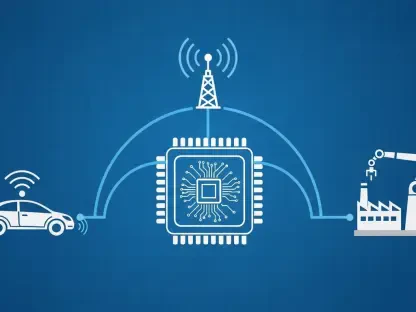Setting the Stage for Connectivity’s Next Leap
In an era where seamless connectivity is no longer a luxury but a necessity, T-Mobile stands at the forefront of a telecommunications revolution, challenging the boundaries of traditional broadband delivery. Imagine millions of users in remote corners of the world, previously cut off from reliable internet, now sending texts or accessing maps via satellite directly from their smartphones. This scenario isn’t a distant dream but a tangible reality being shaped by T-Mobile’s bold strategies in fixed wireless access (FWA) and direct-to-device (D2D) satellite services. This market analysis delves into whether T-Mobile’s satellite ambitions can replicate the remarkable success of its FWA model, which has already disrupted home broadband markets. By examining current trends, competitive dynamics, and future projections, the goal is to uncover the potential impact of this dual-pronged approach on the telecom industry.
Diving into Market Trends and Strategic Moves
FWA’s Unprecedented Growth as a Market Benchmark
T-Mobile’s journey with FWA has redefined expectations in the broadband sector, setting a high bar for its newer satellite initiatives. As of this year, the company boasts an impressive 7.3 million FWA subscribers, a figure that underscores its dominance in delivering high-speed internet to homes through wireless technology rather than traditional wired infrastructure. With a target of reaching 12 million subscribers by 2028, T-Mobile has demonstrated an ability to capture significant market share in urban and suburban areas where demand for flexible broadband solutions continues to surge. This growth trajectory, fueled by consumer preference for cost-effective and easy-to-install internet options, highlights a broader trend toward wireless alternatives in the telecom space.
The success of FWA isn’t just about numbers; it reflects a strategic mastery of market needs and technological deployment. By leveraging existing 5G networks, T-Mobile has managed to offer competitive speeds and reliability, often rivaling fiber-optic services at a fraction of the installation hassle. This model has not only disrupted competitors but also shifted consumer perceptions, positioning wireless as a viable primary internet solution. For stakeholders, this serves as a critical benchmark—any new venture, such as satellite services, must aim to mirror this blend of accessibility and performance to gain traction.
Satellite Services: Emerging Opportunities in D2D Connectivity
Turning to the satellite domain, T-Mobile’s partnership with SpaceX marks a pivotal shift toward addressing connectivity gaps in remote and underserved regions. With over 600 satellites currently operational in a dedicated constellation, the company has successfully rolled out near real-time text messaging capabilities, allowing users to send messages and pictures from virtually any location. This D2D approach, which connects standard mobile devices directly to satellites without specialized hardware, taps into a niche but growing demand for universal access, particularly among rural populations and outdoor enthusiasts.
Market projections suggest that satellite-based connectivity could see exponential growth as consumer awareness increases and technology matures. The planned introduction of a “light data” service this October, enabling applications like mapping tools, indicates a phased strategy to expand use cases beyond emergency communication. However, challenges such as signal consistency across varied terrains and limited bandwidth capacity could temper adoption rates in the short term. Despite these hurdles, the potential to carve out a unique market position in areas where terrestrial networks fail remains a significant driver for investment and innovation.
Competitive Landscape and Technological Barriers
The competitive dynamics surrounding satellite services add another layer of complexity to T-Mobile’s ambitions. As other telecom giants and tech startups eye the satellite space, the risk of market saturation looms, potentially driving down pricing but also increasing pressure to differentiate through superior service quality. T-Mobile’s early mover advantage with SpaceX offers a head start, yet sustaining this lead will require continuous advancements, such as the beta testing of voice calls over satellite using platforms like WhatsApp. Initial results are promising, but scaling this feature to handle widespread demand without compromising clarity remains a technical challenge.
Beyond competition, regulatory constraints around spectrum allocation and the high costs of satellite deployment pose substantial barriers. Industry analysis points to the need for favorable policies to ensure that companies can operate without excessive financial strain. Additionally, consumer education will play a vital role—many still view satellite services as a niche backup rather than a primary option, a perception that must shift for broader market penetration. Balancing these factors will be crucial for T-Mobile to replicate FWA’s transformative impact in this emerging sector.
Forecasting the Future of Hybrid Connectivity
Integration with Terrestrial Networks and 6G Horizons
Looking ahead, the integration of satellite and terrestrial networks emerges as a defining trend in the telecommunications market. T-Mobile’s vision of a hybrid connectivity model, where satellite services complement existing 5G and future 6G infrastructures, could redefine universal access standards. Projections indicate that by 2028, hybrid solutions might account for a significant portion of new connectivity subscriptions, especially in regions lacking traditional infrastructure. This convergence not only addresses coverage gaps but also enhances network resilience, a critical factor in disaster-prone areas.
The advent of 6G technology, expected to roll out in the coming years, promises even faster data transfer and lower latency, potentially amplifying the effectiveness of satellite services. Market analysts anticipate that companies like T-Mobile, which invest early in such synergies, could dominate the next wave of connectivity innovation. However, economic factors such as the high cost of maintaining satellite constellations and securing spectrum rights will influence scalability. Strategic partnerships and government support may become essential to offset these expenses and accelerate market growth.
Niche Markets and Broader Economic Impacts
Focusing on niche markets offers another avenue for satellite services to gain a foothold. Rural communities, maritime industries, and emergency response sectors represent untapped opportunities where T-Mobile’s D2D capabilities could become indispensable. Data suggests that rural internet penetration remains below 60% in many regions, creating a clear demand for alternative solutions. By tailoring offerings to these specific needs—such as affordable data plans or rugged device compatibility—T-Mobile can build a loyal customer base outside urban centers.
Economically, the ripple effects of expanded connectivity could be profound, driving digital inclusion and enabling remote work or education in previously disconnected areas. Yet, the risk of overpromising and underdelivering looms large if technological limitations persist. A balanced approach, focusing on incremental feature rollouts and transparent communication with consumers, will be necessary to maintain trust. As the market evolves, T-Mobile’s ability to adapt to feedback and refine its satellite offerings will likely determine its long-term standing in this space.
Reflecting on Insights and Charting Strategic Pathways
Looking back, this analysis illuminates how T-Mobile’s track record with FWA, marked by 7.3 million subscribers and a goal of 12 million by 2028, provides a robust foundation for its satellite endeavors. The operational success of a 600-satellite constellation and early wins in text and light data services underscore a pattern of innovation against market skepticism. Challenges like voice call scalability and competitive pressures reveal the complexities of pioneering in uncharted territory, yet the potential to bridge connectivity gaps remains undeniable.
For industry stakeholders, the path forward involves prioritizing investments in hybrid connectivity frameworks that seamlessly blend terrestrial and satellite technologies. Businesses are encouraged to explore partnerships that mirror T-Mobile’s collaboration with SpaceX, leveraging shared expertise to reduce costs and accelerate deployment. Consumers in remote regions stand to benefit by staying informed about rollout timelines and advocating for tailored solutions. Ultimately, the telecom sector is poised for transformation, and adopting a mindset of testing small, learning fast, and scaling smart offers the best chance to navigate this dynamic landscape successfully.









